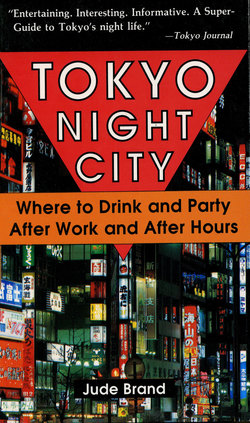Читать книгу Tokyo Night City Where to Drink & Party - Judith Brand - Страница 8
ОглавлениеIntroduction
There are literally hundreds of thousands of bars and clubs in Tokyo. Finding your way through this maze can either be delightfully entertaining or irritatingly frustrating. This volume maximizes your chances of finding what you want and helps to eliminate expensive mistakes. Tokyo Night City offers a comprehensive overview of the nightlife in this city, describes over 100 establishments in detail, tells you what to expect, and shows you how to get there.
Tokyo is full of diversity and subcultures. Since the push for internationalization that emerged during the last decade or so, the range of nightlife available has become even more varied. Now, in addition to the omnipresent nomiya and the exorbitantly expensive hostess club, there are also hundreds of Western-style bars and clubs. By Western I don't mean exact replicas. They are based on a Western concept which has then been reinterpreted to create bars like nowhere else in the world. They are not all new either. Some of them have been around for years, like Lupin, which opened in 1928.
The difference between traditional Japanese drinking establishments and these newer offshoots is pretty simple. In a typical nomiya or hostess club your enjoyment as a customer is based on your relationship with the mama, master, or other member of staff and not so much on your interaction with other customers. But in Western-style bars it is OK to interact as well.
There are now hundreds of these new-era bars but the network of nomiya honeycombing through the city accounts for the thousands in the overall nightspot figure. Because there are so many traditional drinking spots and because your enjoyment of them ends up being so personal, it's up to you to find the best one near your home. But I have included some irresistible little nomiya and the odd hostess club because they have a curious appeal outside their usual realm.
The purpose of this book is to provide entertainment alternatives. No two partiers are alike and every individual has different moods, so I have covered as wide a variety of clubs as possible. As I made my way through Tokyo's previously unmapped night city labyrinth, various groupings of clubs became apparent. These were jazz venues, discos and dance clubs, Latin and reggae bars, gaijin bars, gay and lesbian bars, low-key bars patronized mainly by Japanese, and other hard-to-categorize or one-off establishments. These groupings became the seven chapters of this book: All That Jazz, Dance and Prance, Ethnobop, Gaijin Ghetto, Les Girls and Boys, Mellow Yellow, and Wild Cards. An overview of each scene and an outline of what to expect appears at the beginning of each chapter. There are also two appendixes, one covering Yokohama and the other where to eat late.
The night map of a city always changes more rapidly than its day grid. Descriptions of the clubs listed in these pages will start changing even as the book is being printed. Keep in mind that the names and faces of bars may change, but something usually takes their place. Roppongi will always be relatively easy to plug into, but if that party mecca doesn't satisfy your needs, this book will allow you to find what you want. To keep on top of the turnover of information, regular updates are mandatory and already scheduled for publication.
Each page features a description of the club, lists its hours of operation, address, phone number, and a yen symbol to rate the initial cash outlay necessary to get a drink. ¥ means that your first drink will cost you up to or the equivalent of ¥1,000, ¥¥ means that it will cost you more than ¥1,000 but no more than ¥2,000, and so on. Dance clubs and venues with a cover charge that sometimes include drinks have also been rated according to your initial outlay. If it is ¥3,000 to get in but you get two drinks, it's still going to cost you ¥3,000 to get the first one, so it rates ¥¥¥.
In addition to the above information, each page features a walking map to the club from the closest train station. Symbols used in the maps are:
for the closest subway exit
for a gas station
for a koban, a neighborhood police station
for a temple or shrine
for the location of the club
Japanese words and English words with specialized local meanings have been italicized and explained in the glossary.
So, get out there and grab a thread and follow it through the night city. See you there.
